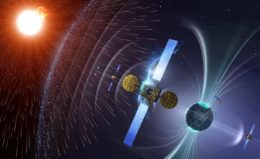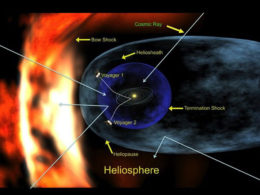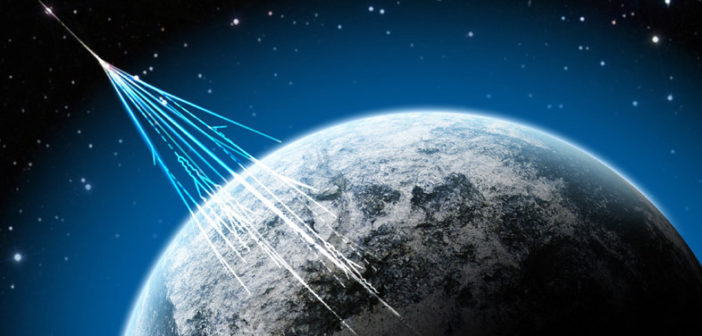The Sun plays an important role in protecting us from cosmic rays, energetic particles that pelt us from outside our solar system. But can we predict when and how it will provide the most protection, and use this to minimize the damage to both piloted and robotic space missions?
The Challenge of Cosmic Rays

Spacecraft outside of Earth’s atmosphere and magnetic field are at risk of damage from cosmic rays. [ESA]
One reason to care about the cosmic rays arriving near Earth is because these particles can provide a significant challenge for space missions traveling above Earth’s protective atmosphere and magnetic field. Since impacts from cosmic rays can damage human DNA, this risk poses a major barrier to plans for interplanetary travel by crewed spacecraft. And robotic missions aren’t safe either: cosmic rays can flip bits, wreaking havoc on spacecraft electronics as well.

The magnetic field carried by the solar wind provides a protective shield, deflecting galactic cosmic rays from our solar system. [Walt Feimer/NASA GSFC’s Conceptual Image Lab]
Shielded by the Sun
Conveniently, we do have some broader protection against galactic cosmic rays: a built-in shield provided by the Sun. The interplanetary magnetic field, which is embedded in the solar wind, deflects low-energy cosmic rays from us at the outer reaches of our solar system, decreasing the flux of these cosmic rays that reach us at Earth.
This shield, however, isn’t stationary; instead, it moves and changes as the strength and direction of the solar wind moves and changes. This results in a much lower cosmic-ray flux at Earth when solar activity is high — i.e., at the peak of the 11-year solar cycle — than when solar activity is low. This visible change in local cosmic-ray flux with solar activity is known as “solar modulation” of the cosmic ray flux at Earth.
In a new study, a team of scientists led by Nicola Tomassetti (University of Perugia, Italy) has modeled this solar modulation to better understand the process by which the Sun’s changing activity influences the cosmic ray flux that reaches us at Earth.
Modeling a Lag
Tomassetti and collaborators’ model uses two solar-activity observables as inputs: the number of sunspots and the tilt angle of the heliospheric current sheet. By modeling basic transport processes in the heliosphere, the authors then track the impact that the changing solar properties have on incoming galactic cosmic rays. In particular, the team explores the time lag between when solar activity changes and when we see the responding change in the cosmic-ray flux.

Cosmic-ray flux observations are best fit by the authors’ model when an 8-month lag is included (red bold line). A comparison model with no lag (black dashed line) is included. [Tomassetti et al. 2017]
This is an important outcome for studying the processes that affect the cosmic-ray flux that reaches Earth. But there’s an additional intriguing consequence of this result: knowledge of the current solar activity could allow us to predict the modulation that will occur for cosmic rays near Earth an entire 8 months from now! If this model is correct, it brings us one step closer to being able to plan safer space missions for the future.
Citation
Nicola Tomassetti et al 2017 ApJL 849 L32. doi:10.3847/2041-8213/aa9373

23 Comments
Pingback: The Sun Is Going Into an Extra Deep Solar Minimum | A Divided World
Pingback: NASA says Voyager 2 is the second human object ever to touch interstellar space — the void between stars
Pingback: NASA says Voyager 2 is the second human object ever to touch interstellar space — the void between stars | JanyoBytes
Pingback: NASA says Voyager 2 is the second human object ever to touch interstellar space — the void between stars – TechFeed
Pingback: NASA says Voyager 2 is the second human object ever to touch interstellar space — the void between stars - CihCih
Pingback: NASA says Voyager 2 is the second human object ever to touch interstellar space — the void between stars | Andre Eger
Pingback: NASA says Voyager 2 is the second human object ever to touch interstellar space — the void between stars | Business Insider
Pingback: It's Official: NASA Just Confirmed Voyager 2 Has Entered Interstellar Space Bizsiziz
Pingback: NASA Just Confirmed Voyager 2 Has Entered Interstellar Space - New Now Science
Pingback: NASA Just Confirmed Voyager 2 Has Entered Interstellar Space | Science News Magazines
Pingback: NASA Just Confirmed Voyager 2 Has Entered Interstellar Space - Science Level
Pingback: NASA Just Confirmed Voyager 2 Has Entered Interstellar Space - Science Alarm
Pingback: NASA Just Confirmed Voyager 2 Has Entered Interstellar Space - Science News 24-7
Pingback: It's official: NASA just confirmed Voyager 2 has entered interstellar space - Science News
Pingback: It's official: NASA just confirmed Voyager 2 has entered interstellar space - Oni Science
Pingback: NASA Just Confirmed Voyager 2 Has Entered Interstellar Space - Science News
Pingback: It's official: NASA just confirmed Voyager 2 has entered interstellar space - Science News Mag
Pingback: It’s Official: NASA Just Confirmed Voyager 2 Has Entered Interstellar Space – Techsemut English
Pingback: It's official: NASA just confirmed Voyager 2 has entered interstellar space - Science Nuclear
Pingback: It's official: NASA just confirmed Voyager 2 has entered interstellar space - Science Technique
Pingback: NASA states Voyager 2 is the 2nd human item ever to touch interstellar area– deep space in between stars | Science & Tech Blog
Pingback: NASA says Voyager 2 is the second human object ever to touch interstellar space — the void between stars - trawlr
Pingback: Looking at “Planet Snowball” and the transition points. | Wandering Through The Night